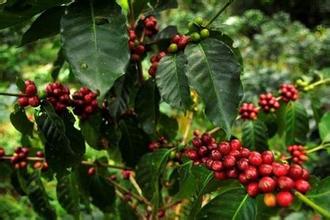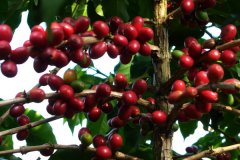What kind of fine coffee is the coffee tree planted in shade?
First of all, there are certain reasons why "shading planting" has become an advantage. When coffee is planted in the shade of other vegetation, biodiversity provides favorable conditions for its growth. Native plants that provide shade for coffee range from forest plants such as cedar to fruit trees such as banana, orange juice, lemon, avocado and litchi, which work together to create a nutrient-balanced soil environment and provide a beneficial and stable specific microclimate (Microclimate) for coffee growth. Similarly, animals such as insects and birds also benefit from the diversity brought by many plants, so that more animals live here, which in turn is beneficial to the pollination of plants in the environment. Finally, those carefully considered planting methods are also beneficial to the health of the soil, thus reducing soil erosion in the planting area.
But what about coffee that doesn't grow in shade? Many of the world's top coffees, grown at high altitudes, are produced in a less "appropriate" way, and there are no other trees to shade them. As a result, we can see that in the world coffee industry, those coffees that get high marks in the standard evaluation mechanism and are regarded as role models may come from areas with ecological diversity and shade planting conditions. it may also come from high-altitude mountain areas that have been exposed to "all-day sun" for a long time.
Despite the different opinions on the effect of shade on coffee taste, at least the current view is that shade planting is undoubtedly a favorable factor for the environment, but this is only one of the many conditions that affect the growth of coffee trees. and thus affect the flavor of coffee.
"Health and quality go hand in hand," said Byron Holcomb, a coffee farmer from Brazil who deliberately grows coffee in full sun. "healthy coffee is more likely to get good quality. From a botanical point of view, coffee is a kind of lower shrub vegetation, it is born to grow under taller trees, and such trees are the so-called shade vegetation for coffee. "
However, it is hard to say that the conditions that provide a healthy environment for coffee growth and benefit the soil have a big impact on the cup of coffee you end up drinking. A study by Shawn Steiman of the University of Hawaii at Manoa focused on the effects of agricultural and forestry conditions on the yield and quality of coffee. He believes that although the amount of sunlight a coffee tree gets has an effect on its flavor, it cannot predict the flavor of coffee at all.
"the taste of coffee is affected by many factors," Steiman said. "if you generalize them with the concept of 'soil conditions', it refers to an interaction between the ecological environment, precipitation conditions and temperature-obviously, plant growth is closely related to them. Therefore, the influence of sunlight only plays a part in the 'local conditions', but it must not be the only factor to be considered. " He added.
Holcomb points out that there are some coffee that are widely respected around the world that do not grow in shade. Kenyan coffee is a good example. "Shade promotes the growth of coffee because it gives coffee a natural environment that is closer to its nature, so I think it promotes some of the characteristics of coffee from a genetic point of view, which in turn makes it taste good in the coffee cup," Holcomb said. "but having said that, the theory of causality is called into question. All other things being equal, shading may not have much effect on coffee quality, and we know that magical Kenyan coffee is grown in a high-altitude environment without shade. "
For shade planting, the more realistic sustainable question is: is it economically a realistic choice for coffee farmers to plant other vegetation at intervals for shade conditions, thereby reducing coffee planting density and resulting in less yield? Especially in the absence of clear evidence that coffee grown in shade tastes better.
And the real influencing factors are more likely to be consumers themselves, especially the feeling that we have when we drink "shade-grown" coffee is the same as when we buy biodiversity, permanently cultured, environmentally friendly coffee-- the feeling that our own views are accepted. That is to say, associating "better" coffee with shade planting is a more romantic view than a more scientific one.

Important Notice :
前街咖啡 FrontStreet Coffee has moved to new addredd:
FrontStreet Coffee Address: 315,Donghua East Road,GuangZhou
Tel:020 38364473
- Prev

What is the fusion degree of milk foam and milk? Milk and coffee
The degree of fusion of foam and milk refers to the degree to which the foam combines with milk after getting rid of the foam. How to judge the fusion degree of milk foam and milk? Principle: just beat the milk foam, the milk foam and milk are mixed together, need to rest for a period of time, the foam and milk will be separated to form layers, and the length of time stands for sending out the foam and milk.
- Next

How to open a coffee shop?
Eight preliminary preparations for opening a coffee shop: 1. Positioning description: describe in detail the appearance of the coffee shop in your mind, which is a key link in the whole project book; 2. Reference to the coffee shop in reality: find a shop that meets or is close to your mind in reality, and at the same time, in repeated contact, you will constantly burst out a lot of inspiration; 3. Fund raising: list rent, decoration and equipment
Related
- Beginners will see the "Coffee pull flower" guide!
- What is the difference between ice blog purified milk and ordinary milk coffee?
- Why is the Philippines the largest producer of crops in Liberia?
- For coffee extraction, should the fine powder be retained?
- How does extracted espresso fill pressed powder? How much strength does it take to press the powder?
- How to make jasmine cold extract coffee? Is the jasmine + latte good?
- Will this little toy really make the coffee taste better? How does Lily Drip affect coffee extraction?
- Will the action of slapping the filter cup also affect coffee extraction?
- What's the difference between powder-to-water ratio and powder-to-liquid ratio?
- What is the Ethiopian local species? What does it have to do with Heirloom native species?

